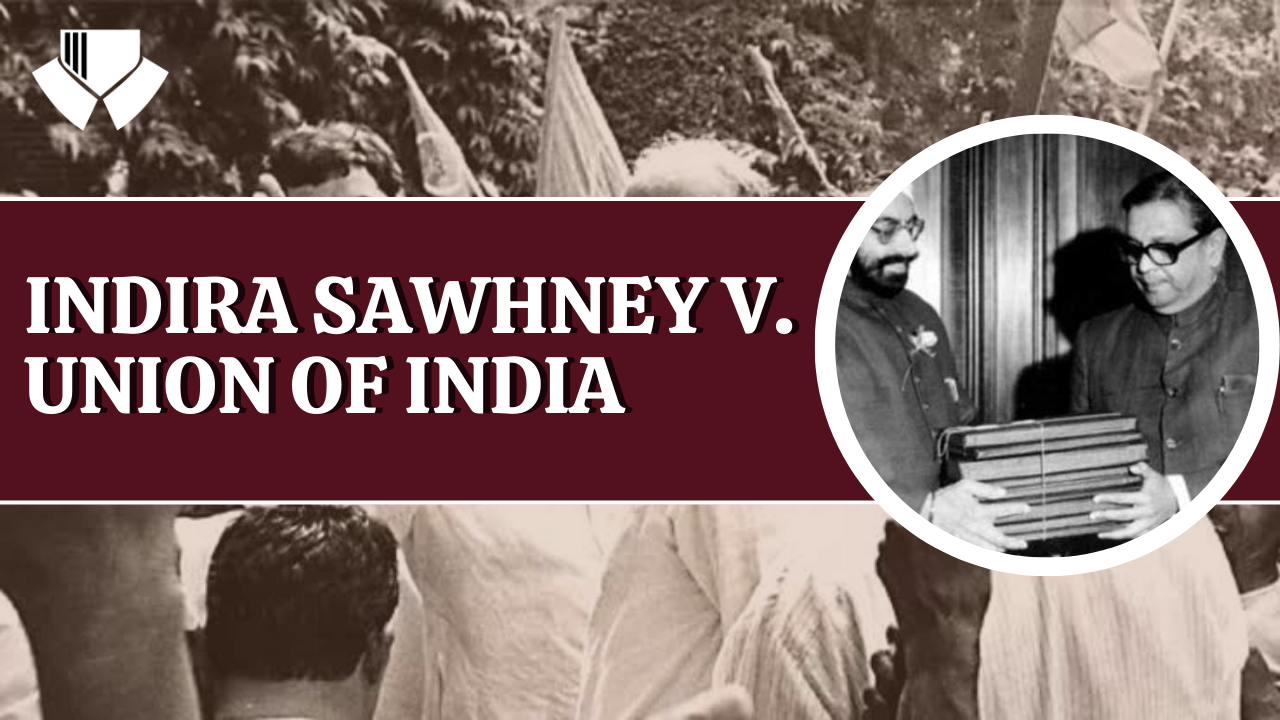This case analysis is done by Yashasvi Gaur, a 2nd year law student at University of Mumbai.
Citation(s): AIR 1993 SC 477; 1992 Supp 2 SCR 454
Bench: M Kania, M Venkatachaliah, S R Pandian, . T Ahmadi, K Singh, P Sawant, R Sahai, B J Reddy
Date of Judgement : 16 November 1992
Background
The Indira Sawhney case, also known as the Mandal Commission case, is a landmark legal case in India that revolves around the issue of reservations for socially and educationally backward classes in public employment and higher education. It was a major turning point in the reservation for Backward Classes in India. The Supreme Court upheld the government order in its judgment, considering caste to be a reasonable indicator of social backwardness. Thus, in 1992, the recommendation for OBC reservations in central government services was eventually put into practice.
Facts
In this case, the petitioner Indra Sawhney filed writ petition against union of India and others regard reservation in India. The backward class formed 1st commission, Kaka kalel kar commission established in 1953, under 340 constitution of India. The purpose of the commission to investigate the condition of backward class. The report submitted by kaka kalel kar on 30th March 1955; is rejected as it is not satisfied by the commission approach to identify backward class under article 15. Again 2nd commission appointed, Mandal commission in January 1st, 1979 by janata Dal under ruling pf prime minister Moraji Desai ruling. In December 1980, the final report submitted by mandal commission to increase the reservation of government quota of 27% from 22.5% reservation of socially and educationally backward class people (schedule caste and scheduled tribes). The mandal commission report was under discussion for long time. Later Narasimha Rao was ruled Congress government in 1991.
He came up with some modifications and introduced new office memorandum which consists 27% reservation for SEBC in civil post and services under government of India and further added 10% reservation for economically challenged section, which are not covered in any reservation schems and issued criteria for economically challenged section seperately. By this action, many people started revolting against it and lot of people lost their life and property. At last supreme court of India came down to balance judicial pragmatism and political opportunism, by consists all petitions regarding the report of Mandal commission in 11 September 1990.
Issues
- Whether caste is a factor to determine backward class, and whether economic criteria may be used to classify people?
- Whether Article 16(4) is an exception to Article 16(1)?
- Whether executive have powers to issue order under Article 16(4)?
Contentions of the Petitioners (Challengers of Reservations):
- Constitutional Validity: The petitioners challenged the constitutional validity of providing reservations for Other Backward Classes (OBCs) in public employment and educational institutions. They argued that this violated the fundamental principle of equality enshrined in the Indian Constitution.
- 50% Cap on Reservations: The petitioners contended that the 27% reservation for OBCs exceeded the 50% cap on total reservations set by previous Supreme Court judgments. They argued that such an extension violated the established legal limits on reservations.
- Creamy Layer: Petitioners also questioned the concept of the “creamy layer” within the OBC category. They argued that excluding the creamy layer from reservations was insufficient in ensuring that the benefits of affirmative action reached the genuinely disadvantaged sections of OBCs.
- Reservations in Promotions: The petitioners opposed reservations in promotions within government jobs, arguing that this would compromise efficiency, create reverse discrimination, and hinder the career prospects of general category candidates.
Contentions of the Respondents (Supporters of Reservations):
- Constitutional Validity: The government and its supporters, including many OBC organizations, argued that reservations for OBCs were constitutionally valid. They contended that affirmative action was essential to uplift socially and educationally backward classes and to address historical injustices.
- 50% Cap on Reservations: The respondents argued that the 50% cap on reservations should not be treated as a strict, inflexible rule. They contended that in exceptional circumstances, the cap could be exceeded if there was empirical data to justify it.
- Creamy Layer: Supporters of reservations maintained that excluding the creamy layer was a fair practice to ensure that the most disadvantaged sections of OBCs received the benefits of reservations. They argued that including the creamy layer would not serve the intended purpose of social justice.
- Reservations in Promotions: The government and OBC organizations defended reservations in promotions as necessary to rectify historical discrimination and underrepresentation of OBCs in government jobs. They contended that this was a crucial step towards social equality.
- Data and Empirical Justification: Respondents emphasized the need for empirical data to establish the extent of backwardness among OBCs and to demonstrate the necessity of reservations. They argued that reservations should be based on a rational and evidence-based approach.
- Balancing Social Justice and Efficiency: The supporters of reservations argued that while efficiency was important, it should not come at the expense of social justice. They maintained that reservations were a means to achieve a more equitable and just society.
Judgement
The judgment, authored by a nine-judge bench, is extensive and covers various aspects of reservations and affirmative action policies in India. Below is a detailed summary of the key points and findings of the judgment:
- 50% Cap on Reservations: The Supreme Court upheld the 50% cap on total reservations in public employment and educational institutions. It stated that while reservations were permissible, they should not exceed this limit to maintain the overall efficiency and quality of public services.
- Creamy Layer: The court introduced the concept of the “creamy layer” within the OBC category. It ruled that individuals within the OBC community who belonged to the creamy layer, meaning they were relatively more economically and socially advanced, should not be eligible for reservations. This was done to ensure that the benefits of reservations reached the genuinely disadvantaged sections of OBCs.
- Reservations in Promotions: The judgment held that reservations in promotions were generally not permissible, except in cases of inadequate representation of Scheduled Castes (SCs) and Scheduled Tribes (STs) in government jobs. Reservations in promotions should be a last resort to address such representation gaps.
- Data and Empirical Justification: The court emphasized the importance of collecting empirical data to establish the extent of backwardness among OBCs and to demonstrate the necessity of reservations. It stated that reservations should be based on a rational and evidence-based approach.
- Inadequate Representation of SC/ST: The judgment affirmed the constitutional validity of reservations for SCs and STs and allowed these reservations to exceed the 50% cap. The court recognized the historical discrimination and underrepresentation faced by these communities.
- Social Justice vs. Efficiency: The Supreme Court acknowledged the need to balance social justice and affirmative action with the efficiency of public services. It recognized the importance of ensuring equal opportunities for all citizens while maintaining the quality of governance.
- Role of State and Executive: The judgment emphasized the responsibility of the state and the executive in implementing reservations and affirmative action policies. It noted that the government should continuously review the impact of such policies and make adjustments as necessary.
- Future Policy Adjustments: The court recognized that social and economic conditions in India are dynamic and evolving. It suggested that the government should periodically reexamine and reevaluate its reservation policies to ensure that they remain relevant and effective.
- Interaction with Other Constitutional Provisions: The judgment discussed the interaction between Article 15(4) (which allows for reservations) and Article 16(4) (which deals with reservations in public employment) of the Indian Constitution. It clarified the relationship between these provisions.
- State-wise Implementation: The judgment allowed for state-specific data and conditions to be taken into account when implementing reservations, recognizing that backwardness can vary from state to state.
Conclusion
In conclusion, the Indira Sawhney case judgment provided important legal guidelines and limitations on reservations in India. It sought to strike a balance between social justice and administrative efficiency and introduced the concept of the creamy layer to ensure that reservations benefited the most disadvantaged sections of society. The judgment continues to shape India’s affirmative action policies and remains a significant legal precedent in the country.


